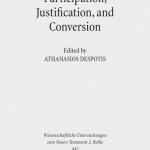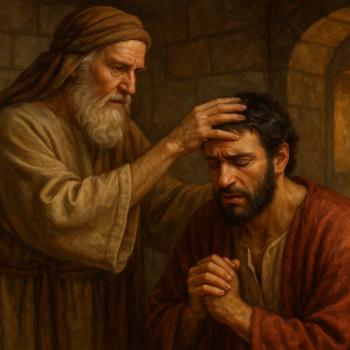What does the gospel according to Paul look like from a traditional Protestant perspective? This question is relevant for someone like me who compares and evaluates theological perspectives on Paul. A fellow scholar recently mentioned to me that in his earlier years he was influenced by Archibald M. Hunter’s book, The Gospel According to St. Paul (London: SCM, 1966/Philadelphia: Westminster, 1967).
Dr. Hunter was Yates Professor of New Testament Greek and Exegesis at Mansfield College, Oxford. He then became Professor of New Testament at the University of Aberdeen, Scotland. Originally, he wrote this book in 1954 under the title, Interpreting Paul’s Gospel before revising and retitling it twelve years later.
As a moderately critical scholar from the 20th century, Hunter adopts ten of Paul’s letters as genuine, all except the Pastoral letters (1–2 Timothy, Titus). Here are some takeaways from his gospel according to Paul:

Influenced by the Damascus Road Experience
In agreement with a number of scholars, Hunter regards as significant Paul’s experience with Christ on the way to Damascus (Gal 1:11–16; Acts 9). This encounter shaped his theology. The implications of this event, however, took time to become clear to Paul. Hunter distills “three decisive consequences” resulting from it:
(1) Paul encountered Jesus of Nazareth who was alive as Messiah.
(2) Paul understood now that Jesus was crucified but risen again, and his death was “for us.”
(3) Paul considered salvation to be by divine grace (charis). This term becomes for Paul “almost a single-word expression for the Gospel he preached” (p. 13).
Paul’s Gospel of Salvation
Hunter interprets Paul’s gospel foremost though the term “salvation” (soteria). Paul calls his gospel “the gospel of your salvation” in Ephesians 1:13, the “power of God for salvation” in Romans 1:16, and the “word of salvation” during his first sermon depicted in Acts 13:26. Salvation signifies bodily and spiritual soundness, well-being “in all its forms,” and deliverance from sin and death. Paul stresses not only the notion of being saved from such things as sin, but also being saved to other things such as “reconciliation and righteousness and life” (p. 15).
According to Hunter, Paul uses salvation in terms of a past event (Rom 8:24), present experience (1 Cor 15:2), and future hope (Rom 5:9).
Salvation as a Past Event
Salvation as a past event looks back to the crucifixion, the finished work of Christ on the cross.
The Human Predicament
The human predicament was such that sin enslaved humans, making use of their “flesh” (sarx) to do so. In this predicament, humans also attempted to secure salvation by Mosaic (and natural) Law, which involved trying to attain salvation through their own efforts and strength. Hunter identifies this as “legalism.”
If the predicament is described by the threefold notions of sin, the flesh, and the law, its remedy takes place by means of redemption, justification, and reconciliation (p. 19).
The Remedy
Redemption involves deliverance from sin’s servitude (Eph 1:7; Col 1:14; Rom 3:24; 1 Cor 6:20; cf. Mark 10:45). Hunter brings up from Greco-Roman tradition an illustration made famous by Adolf Deissmann (Light from the Ancient East)—“sacral manumission.” The term refers to slaves purchasing their freedom via a ritual in which their masters sell them to a temple god and receive the lutron (money paid from the slave’s earnings). The slave now symbolically becomes a servant to the god but is freed from his human master. The exodus narrative in which Israel was delivered from Egyptian slavery provides another example.
Justification not only has to do with divine acquittal or being declared righteous (Rom 8:32-33) but also forgiveness (Rom 4:6–8). Hunter, who follows John Wesley on this, emphasizes the point. He also understands “the righteousness of God” (Rom 1:17) as a divine activity involving God’s saving and vindicating action (Isa 56:1; Psa 98:2). Here it seems that Hunter may be influenced by Ernst Käsemann, though in the Preface he only mentions by name Joachim Jeremias, T. W. Manson, and Oscar Cullmann.
Reconciliation assumes relationships. In this case, sin has alienated the human from a relationship in which he or she is to be restored to “God’s family circle” (p. 23; Rom 5:10–11; 2 Cor 5:18–20; Eph 2:16; Col 1:19ff). Reconciliatory change targets not the person’s legal status but his/her entire life; the believer becomes a “new creature” (2 Cor 5:17).
Faith involves utter trust. It is opposed to works as a condition of salvation (meritorious human effort), but this is not the same things as “good works.” The latter is a consequence of salvation (such as faith working through love: Gal 5:6).
Salvation as a Present Experience
Salvation is also a present experience for Hunter. This experience segues from justification to sanctification, or what the German theologians call Gabe und Aufgabe, gift and task (cf. Col 1:13; Rom 1:17; 5:2).
To be “in Christ” is to belong to the body of Christ, the Church, which connects the individual to fellow believers. This state likewise describes the living presence of Christ through the Holy Spirit: to be “in Christ” is to be “in the Spirit.” “The Spirit is God in Christ at work in men, helping, inspiring, illuminating, quickening, sanctifying” (p. 37; cf. 35).
The present experience highlights the importance of ethics. Believers are to live in a manner “worthy of the Gospel of Christ” (Phil 1:27; cf. Eph 4:1; Col 3:1). Pauline moral behavior includes acting as Christ did (imitating Christ), acting as Christ directed (following the law of Christ: Gal 6:2; 1 Cor 9:21; his moral teachings), acting as members of the body of Christ, and acting in love (apape, esp. p. 47).
Salvation as a Future Hope
Finally, salvation includes a future hope. Here Hunter brings up Oscar Cullmann’s World War II illustration of believers currently living, as it were, between D-Day and V-Day in God’s salvific calendar. Salvation is already realized in the sense of a decisive action that took place on the cross (“D-Day”), but “V-Day” is yet to come. The latter involves the Parousia or “royal coming” of the Lord Jesus Christ (p. 52). There will also be a general resurrection from the dead, final judgment, and manifestation of the eternal kingdom of God.
My Reflections
Hunter interprets Paul’s gospel in a more-or-less standard fashion for 20th-century Protestantism. This gospel centers on salvation, which is quite understandable given the many Pauline passages relevant to soteriology. Paul, however, seems to be more interested in the salvation of Jews and gentiles as people groups than Hunter brings out. He wants to focus on the salvation of individuals.
His stress on soteriology centers on the function of the gospel more so than its content. The content of the gospel is Jesus identified as Messiah, Lord, and Son of God, who died on the cross for us and rose again (1 Cor 15:1–4; Rom 1:1–4). The function of the gospel is what it intends to do and how it is to be appropriated—Jews and gentiles are to believe (that is, trust in) the gospel’s content and follow the person it proclaims. This is where Hunter’s select passages from Roman 1:16 (and v. 17) and Ephesians 1:13 fit in. Since he accepts Ephesians and Colossians as genuinely Pauline, these letters enhance his viewpoints.
It seems that Hunter uses Paul’s gospel and Paul’s theology somewhat interchangeably. In many ways they can indeed be interchangeable, but we should recognize that “gospel” is Paul’s term, and “theology” is ours.
Commendation
Rightly, in my opinion, Hunter brings out the importance of Paul’s Damascus experience as a sort of fountainhead for his theology. His inclusion of being “in Christ,” the importance of the Holy Spirit’s work, and the goal of restoring the divine “family” (a prelude to N. T. Wright), are all commendable features that seem to be ahead of their time.
Critique
A glaring distinction between Hunter’s position and newer perspectives on Paul centers on Mosaic Law. Tremors of a new perspective in this regard were already being felt through Krister Stendahl’s work, even as Hunter revised his book in the 1960’s. The 1970’s would then experience ground-breaking change with E. P. Sanders’s Paul and Palestinian Judaism that birthed the New Perspective on Paul. Sanders demonstrated through Second Temple Jewish literature that the “Judaism” of that time was a religion marked by grace. It will no longer do to claim that ancient Judaism was a legalistic religion of works-righteousness, as characterized by many Protestants at that time, including A. M. Hunter. Since then, Sanders has faced his share of critics, but his point about grace in Second Temple Judaism has stood the test of time fairly well.
On the other hand, in relation to Hunter and the older perspective, what has also stood the test of time is that, for Paul, Mosaic law does not save—trust in Jesus Messiah is what saves.
Another shortcoming in Hunter’s study is that he fails to unpack the meaning of the term “gospel.” The gospel (euangelion and its verb cognate) refers to the “good news,” as I have explained in a previous blog. For Paul the term seems to be derived from Jewish Scripture (Psalms 39[40]:10; 95[96]:2; Isa 40:9; 52:7; 60:6; 61:1; Nah 1:15), significantly Isaiah 52:7 which he quotes in Romans 10:15. As well, he may have known some traditions about Jesus’s use of the term (e.g., Mark 1:14–15; Luke 4:16–21).
Moreover, the gospel communicates not only salvation, but also the inbreaking of a new era, the hope of the restoration of Israel, the ingathering of the nations (gentiles), and of course, its message becomes centered on the person of Jesus as Messiah.














